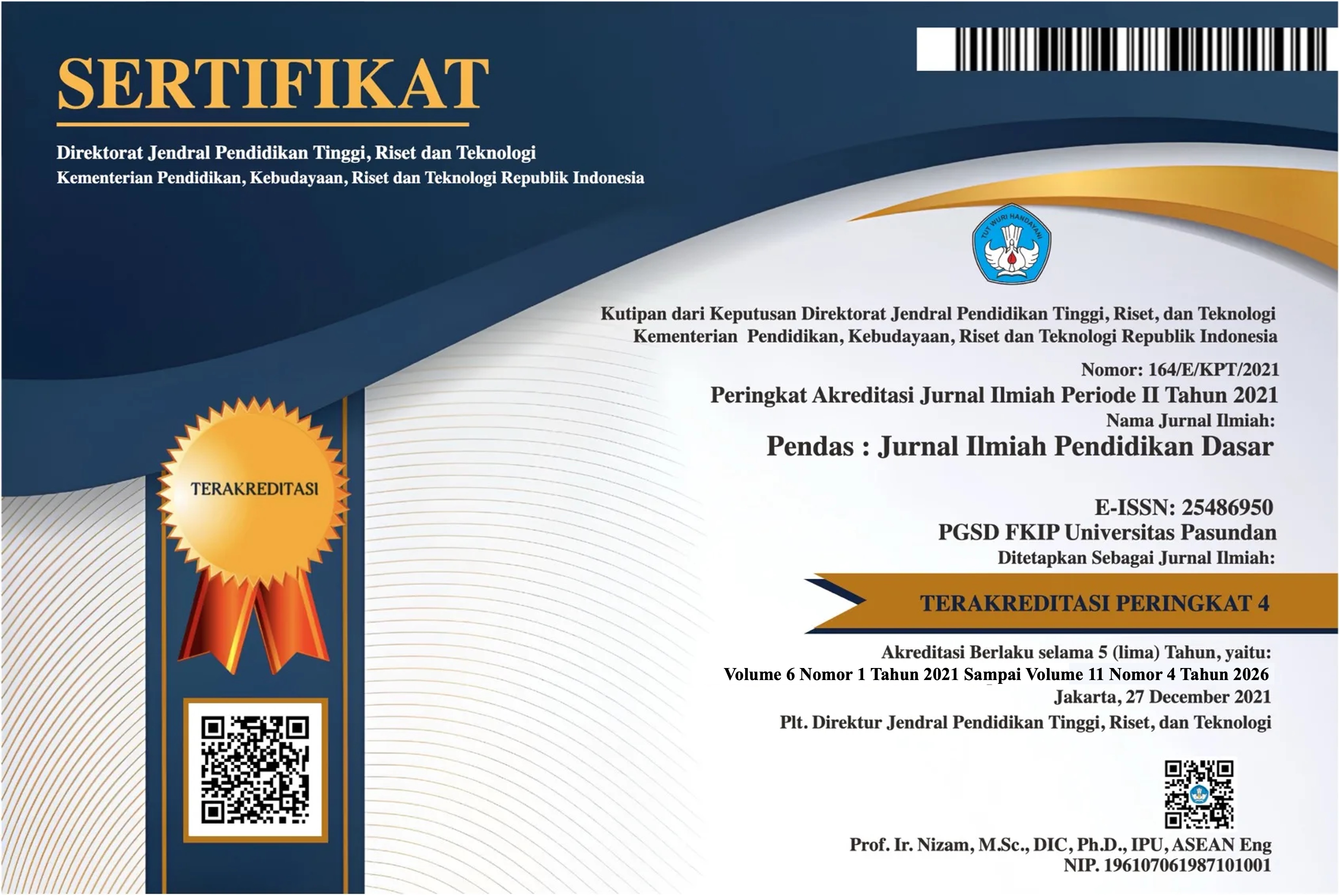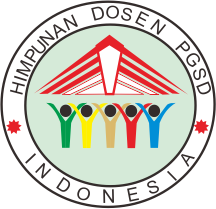HUBUNGAN MOTIVASI BELAJAR DAN KEMANDIRIAN BELAJAR DENGAN HASIL BELAJAR DALAM PEMBELAJARAN BERDIFFERENSIASI PADA MATERI PECAHAN KELAS IV SDN 27 SINGKAWANG
DOI:
https://doi.org/10.23969/jp.v9i3.17353Keywords:
Learning Motivation, Learning Independence, Learning Outcomes, Differentiated LearningAbstract
This research was motivated by the low level of achievement of students' mathematics learning mastery, which based on student learning outcomes did not reach the KKM score. This research aims to describe the relationship between learning motivation and learning independence with mathematics learning outcomes; 2) knowing the achievement of learning outcomes in differentiated learning can help students achieve the minimum completeness criteria (KKM). This research method is correlation research with a quantitative approach. The research population was all fourth grade students at SDN 27 Singkawang. The sample in this research was class IV A students at SDN 27 Singkawang, totaling 29 students. Data was obtained through learning outcomes test instruments as well as questionnaires on student learning motivation and learning independence. The data analysis techniques used are Pearson product moment correlation, multiple correlation, and one sample t-test. The results of the research show that 1) There is a relationship between learning motivation and student learning outcomes, obtained by the Pearson product moment correlation coefficient of 0.783 which is in the strong relationship category. 2) There is a relationship between learning independence and student mathematics learning outcomes obtained by the Pearson product moment correlation coefficient. amounting to 0.902 which is in the strong relationship category. 3) There is a relationship between learning motivation and learning independence and student learning outcomes, resulting in a multiple correlation coefficient of 0.906 which is in the relationship category. 4) From the results of calculating student learning outcomes data, the coefficient results are one sample t-test with Asymp. Sig (2-tailed) = 0.000, then 0.000 < 0.05 so it can be concluded that the ability to understand concepts in differentiated learning can help class IV A students at SDN 27 Singkawang achieve the minimum completeness criteria (KKM).
Downloads
References
Abi, M. N., Kasman, R., & Angelia, P. R. (2022). Hubungan Motivasi Belajar dengan Hasil Belajar Siswa pada Pelajaran PAI. JPG: Jurnal Pendidikan Guru, 3(4), 276-283.
Al Fatihah, M. (2016). Hubungan antara kemandirian belajar dengan prestasi belajar PAI siswa kelas III SDN Panularan Surakarta. At-Tarbawi: Jurnal Kajian Kependidikan Islam, 1(2), 197-108.
Ali, S., Moonti, U., & Yantu, I. (2022). Pengaruh Motivasi Dan Kemandirian Belajar Terhadap Hasil Belajar Siswa Pada Mata Pelajaran IPS Terpadu Kelas VIII Di SMP Negeri 1 Bulango Utara Kabupaten Bone Bolango. Aksara: Jurnal Ilmu Pendidikan Nonformal, 8(2), 1553-1560.
Ali, S., Moonti, U., & Yantu, I. (2022). Pengaruh Motivasi Dan Kemandirian Belajar Terhadap Hasil Belajar Siswa Pada Mata Pelajaran IPS Terpadu Kelas VIII Di SMP Negeri 1 Bulango Utara Kabupaten Bone Bolango. Aksara: Jurnal Ilmu Pendidikan Nonformal, 8(2), 1553-1560.
Alim, N., & Yunisrul, Y. (2020). Hubungan Motivasi Belajar Siswa dengan Hasil Belajar Siswa Dalam Pembelajaran IPS Di Sekolah Dasar. Journal of Basic Education Studies, 3(2), 245-256.
Aminullah, A., & Masnur, M. (2019). Hubungan Antara Keterlaksanaan Praktikum IPA Dan Motivasi Belajar Dengan Hasil Belajar IPA Siswa Kelas VIII SMP Negeri Di Kabupaten Enrekang. Prosiding, 4(1).
Andriani, R., & Rasto, R. (2019). Motivasi belajar sebagai determinan hasil belajar siswa. Jurnal pendidikan manajemen perkantoran, 4(1), 80-86.
Apriyantini, N. P. D., & Sukendra, I. K. (2023). Penerapan Pembelajaran Berdiferensiasi Berbantuan E-LKPD Untuk Meningkatkan Keaktifan Belajar Matematika Siswa. Widyadari, 24(1), 55-63.
Awe, E. Y., & Benge, K. (2017). Hubungan antara minat dan motivasi belajar dengan hasil belajar ipa pada siswa SD. Journal of Education Technology, 1(4), 231-238.
Azra, F. I., & Jamil, H. (2015). Pengaruh lingkungan keluarga dan motivasi belajar siswa terhadap hasil belajar akuntansi siswa kelas X SMK Negeri 1 Solok selatan. Economica: Journal of Economic and Economic Education, 2(2), 85-98.
Batubara, S., & Nugroho, R. R. (2021). Hubungan motivasi belajar dengan kemandirian belajar siswa kelas IX MTsN 28 Jakarta Pada Masa Pandemi. Guidance: Jurnal Bimbingan dan Konseling, 18(01), 8-16.
Faiz, A., Pratama, A., & Kurniawaty, I. (2022). Pembelajaran berdiferensiasi dalam program guru penggerak pada modul 2.1. Jurnal basicedu, 6(2), 2846-2853.
Fauziah, N., Sobari, T., & Supriatna, E. (2021). Hubungan motivasi belajar dengan kemandirian belajar siswa smpn 6 garut. Fokus (Kajian Bimbingan & Konseling dalam Pendidikan), 4(1), 49-55.
Febyanita, I., & Wardhani, D. A. P. (2020). Pengembangan media puzzle materi siklus air untuk meningkatkan motivasi belajar siswa. Jurnal inovasi penelitian, 1(6), 1205-1210.
Gusteti, M. U., & Neviyarni, N. (2022). Pembelajaran berdiferensiasi pada pembelajaran matematika di kurikulum merdeka. Jurnal Lebesgue: Jurnal Ilmiah Pendidikan Matematika, Matematika Dan Statistika, 3(3), 636-646.
Halidjah, S. (2021). Hubungan motivasi dan kemandirian dengan hasil belajar mahasiswa pgsd fkip untan. Jurnal Pendidikan Dasar, 9(2), 182-194.
Hasibuan, I. (2015). Hasil belajar siswa pada materi bentuk Aljabar di Kelas VII SMP Negeri 1 Banda Aceh tahun pelajaran 2013/2014. Jurnal peluang, 4(1).
Herwina, W. (2021). Optimalisasi kebutuhan murid dan hasil belajar dengan pembelajaran berdiferensiasi. Perspektif Ilmu Pendidikan, 35(2), 175-182.
Khalishah, N., & Iklilah, N. (2021, December). Taksonomi Bloom (Revisi): Tujuan Pendidikan dan Implementasinya dalam Pembelajaran Matematika. In SANTIKA: Seminar Nasional Tadris Matematika (Vol. 1, pp. 248-266).
Downloads
Published
Issue
Section
License
Copyright (c) 2024 Pendas : Jurnal Ilmiah Pendidikan Dasar

This work is licensed under a Creative Commons Attribution 4.0 International License.



















